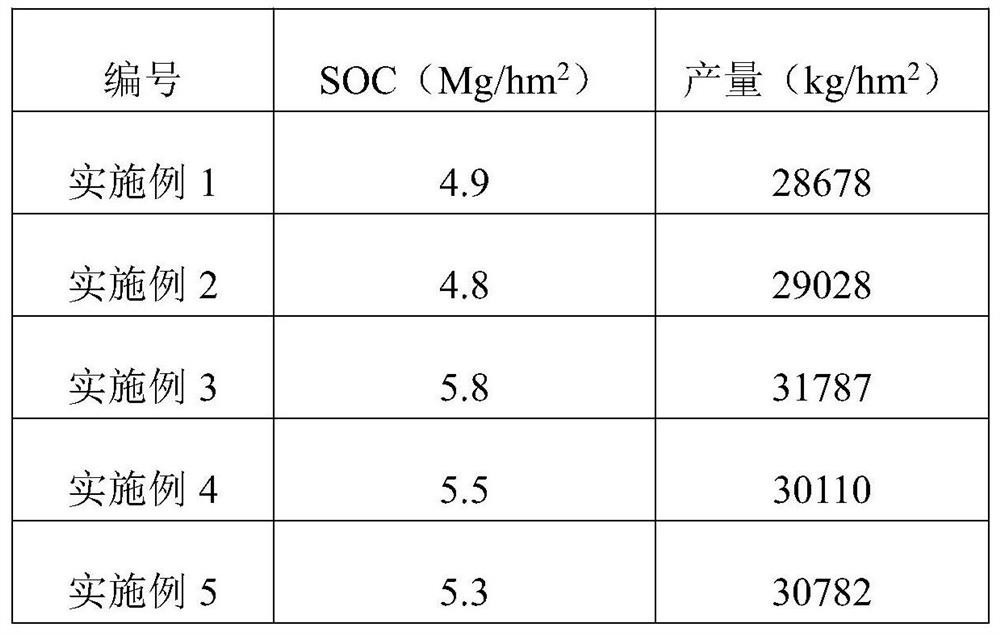A method for carbon sequestration in sandy soil in the field
A sandy soil and field technology, applied in the field of sandy soil carbon sequestration in the field, can solve the problem of limited improvement of carbon sequestration capacity per plant, and achieve the effects of increasing field planting yield, carbon sequestration capacity, and fertilizer efficiency
- Summary
- Abstract
- Description
- Claims
- Application Information
AI Technical Summary
Problems solved by technology
Method used
Image
Examples
Embodiment 1
[0020] The carbon fixation regulator described in this embodiment includes the following components in parts by weight: 30 kg of biogas residue, 30 kg of wood vinegar, 8 kg of bentonite, and 15 kg of seaweed residue.
[0021] The wood vinegar is prepared according to the following steps: using straw crops as raw materials, according to methods known in the prior art, performing oxygen-limited pyrolysis carbonization at 350-550 ° C to produce biomass charcoal, pyrolysis gas spraying, cooling to produce the water-soluble acidic liquid, collect the separated liquid product, which is crude wood vinegar; and filter the obtained crude wood vinegar with walnut shells and diatomaceous earth to remove tar and impurities contained, and obtain refined wood vinegar, After simple distillation, that is.
[0022] The biogas residue is obtained by modifying according to the following steps:
[0023] (1) Take the biogas residue formed by the fermentation of livestock and poultry manure and pu...
Embodiment 2
[0028] The carbon fixation regulator described in this embodiment includes the following components in parts by weight: 50 kg of biogas residue, 20 kg of wood vinegar, 15 kg of bentonite, and 5 kg of seaweed residue.
[0029] Described wood vinegar is identical with embodiment 1.
[0030] The biogas residue is obtained by modifying according to the following steps:
[0031] (1) Take the biogas residue formed by the sludge and pulverize it with a pulverizer and carry out vacuum drying until the moisture content is lower than 10%;
[0032] (2) In a closed container equipped with 1-butyl-3-methylimidazolium tetrafluoroborate ionic liquid, control the biogas residue without contacting with the ionic liquid, and the 1-butyl-3 -The addition volume of methylimidazole tetrafluoroborate accounts for 1% of the volume of the reaction vessel;
[0033] (3) The temperature of the reaction vessel is raised to 60°C, and the air is exhausted, and then the vessel is filled with CO 2 Gas, and...
Embodiment 3
[0036] The carbon fixation regulator described in this embodiment includes the following components in parts by weight: 40 kg of biogas residue, 25 kg of wood vinegar, 12 kg of bentonite, and 10 kg of seaweed residue.
[0037] Described wood vinegar is identical with embodiment 1.
[0038] The biogas residue is obtained by modifying according to the following steps:
[0039] (1) Take the biogas residue formed by plant straw fermentation and grind it with a pulverizer and vacuum-dry it until the moisture content is lower than 10%;
[0040] (2) In a closed container filled with 1-ethyl-3-methylimidazolium tetrafluoroborate and 1-butyl-3-methylimidazolium tetrafluoroborate ionic liquid (1:1v / v) , controlling the biogas residue not in contact with the ionic liquid, the added volume of the ionic liquid accounts for 0.8% of the volume of the reaction vessel;
[0041] (3) The temperature of the reaction vessel is raised to 50°C, and the air is exhausted, and then the vessel is fill...
PUM
 Login to View More
Login to View More Abstract
Description
Claims
Application Information
 Login to View More
Login to View More - R&D
- Intellectual Property
- Life Sciences
- Materials
- Tech Scout
- Unparalleled Data Quality
- Higher Quality Content
- 60% Fewer Hallucinations
Browse by: Latest US Patents, China's latest patents, Technical Efficacy Thesaurus, Application Domain, Technology Topic, Popular Technical Reports.
© 2025 PatSnap. All rights reserved.Legal|Privacy policy|Modern Slavery Act Transparency Statement|Sitemap|About US| Contact US: help@patsnap.com


